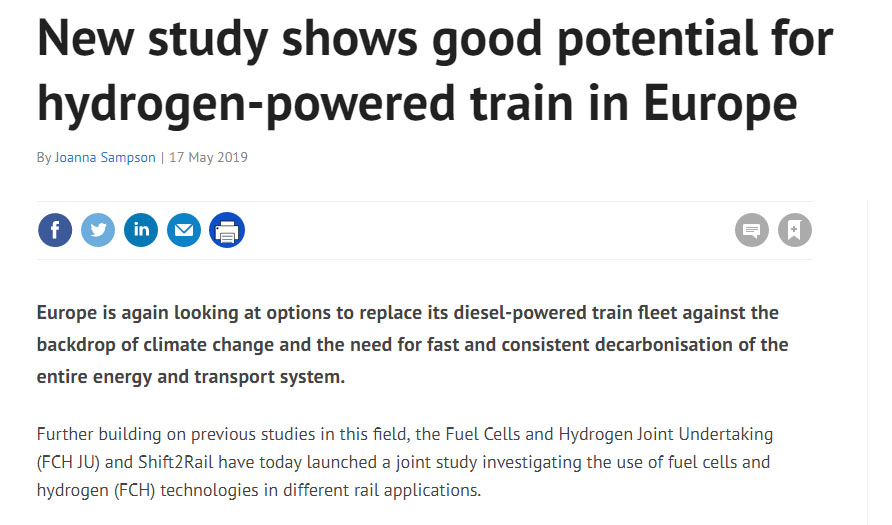
Europe is again looking at options to replace its diesel-powered train fleet against the backdrop of climate change and the need for fast and consistent decarbonisation of the entire energy and transport system.
Further building on previous studies in this field, the Fuel Cells and Hydrogen Joint Undertaking (FCH JU) and Shift2Rail have today launched a joint study investigating the use of fuel cells and hydrogen (FCH) technologies in different rail applications.
Hydrogen-powered trains are equipped with fuel cells that produce electricity through a combination of hydrogen and oxygen, a process that leaves water as the only emissions.
The study says FCH technology provides a flexible, zero emission and potentially cost-competitive solution to replace diesel trains, and by 2030 one in five new trains in Europe could be powered by hydrogen.
It assesses the business case, the market potential, 10 specific case studies and the main barriers to the use of FCH technologies in different rail applications.
“Hydrogen is one of the best technologies to decarbonise transportation, providing an attractive alternative to many cities and regions struggling to combat air pollution,” said Bart Biebuyck, Executive Director of the FCH JU.
Exclusive interview with Bart Biebuyck
“Various regions in Europe have shown interest in the potential of fuel cell and hydrogen technologies for trains, in particular where other electrification alternatives to reach the zero-emission objectives have proven unfeasible from a technical and also an economical point of view.”
The analysis of ten selected case studies across Europe revealed attractive use cases and potential boundary conditions for FCH technologies in the rail environment.
Several barriers were also identified that must be overcome in order to unlock its full potential.
Three targeted research and innovation topics have been proposed as the means to tackle the most important of these barriers.
“The analysis finds that the global FCH train market development activities are currently concentrated in Europe,” said Carlo Borghini, Executive Director of Shift2Rail.
“This is encouraging as it puts Europe at the forefront of FCH train technology, which constitutes a significant potential for the European FCH industry.”
“The rail system transformation initiated with the establishment of the Shift2Rail Programme, driven by sustainability, digitalisation and automation, creates new market opportunities for the competitiveness of the rail industry globally.”
The hydrail concept and transformation has been continuously in development since at least 2003, when the Mooresville Hydrail Initiative proposed passenger hydrail to the US Department of Transportation (DOT) by invitation. In Europe, the Mooresville Hydrail Initiative began networking Denmark with the US, Japan and China back in 2005.
Since then, various developments and events have taken place in Europe and around the world to further the hydrail concept.
https://www.gasworld.com/study-shows-good-potential-for-hydrogen-trains/2017216.article



